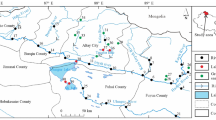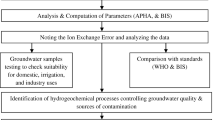Abstract
Sixty water samples (35 groundwater samples, 22 surface water samples and three hot-spring water samples) were collected at 36 points from villages and towns in Lhasa city, Nagchu (Nagqu) prefecture, Ali (Ngari) prefecture and Shigatse (Xigaze) prefecture (Tibet) in 2013 to study the hydrochemical characteristics and element contents of natural waters. The concentrations of elements were determined in the water samples and compared with the concentrations in water samples from other regions, such as southeast Qinghai, south Xinjiang, east Sichuan and west Tibet. The hydrochemical species in different areas were also studied. Water in most parts of Tibet reaches the requirements of the Chinese national standard and the World Health Organization international standard. The pH values of the water samples ranged from 6.75 to 8.21 and the value for the mean total dissolved solids was 225.54 mg/L. The concentration of arsenic in water from Ali prefecture exceeded the limit of both the Chinese national standard and the international standard and the concentration of fluoride in water from Shuanghu exceeded the limit of both the Chinese national standard and the international standard. The main hydrochemical species in water of Tibet is Ca (HCO3)2. From south to north, the main cation in water changes from Ca2+ to Na+, whereas the main anions in water change from HCO3 − to Cl− and SO4 2−. The chemistry of river water and melt water from ice and snow is dominated by the rocks present at their source, whereas the chemistry of groundwater is affected by many factors. Tectonic divisions determine the concentrations of the main elements in water and also affect the hydrochemical species present.
Similar content being viewed by others
References
Bianduo, Bianbaciren, Laba et al., 2010. The response of water level of Selin Co to climate change during 1975–2008. Acta Geographica Sinica, 65(3): 313–319. (in Chinese)
Buduo, Jiang D S, Ren J Y et al., 2011. Preliminary study on the arsenic water of fisheries in Lhasa Region. Journal of Tibet University, 26(1): 15–24. (in Chinese)
Cao N, 2011. An analysis of the characteristics of geological environment in the Kashin-Beck disease (KBD) area in the Rangtang county [D]. Chengdu: Chengdu University of Technology. (in Chinese)
Chen L, Wang G C, Hu F S et al., 2014. Groundwater hydrochemistry and isotope geochemistry in the Turpan Basin, northwestern China. Journal of Arid Land, 6(4): 378–388.
Du J T, 2011. Hydrogeochemical research of Kashin-Beck disease [D]. Chengdu: Chengdu University of Technology. (in Chinese)
General Administration of Quality Supervision, Inspection and Quarantine of the People’s Republic of China (GAQS), 2008. GB 8537-2008. Drinking Natural Mineral Water. (in Chinese)
Gibbs R J, 1970. Mechanisms controlling world water chemistry. Science, 170: 1088–1090.
Hirokazu H, Yoshiki W, Satoshi O, 1985. Silver chloride pre-treatment for the direct potentiometric determination of chloride in stream waters using a solid-state chloride ion-selective electrode. Analyst, 110(9): 1087–1090.
Ji Q G, Wang B Q, 2007. The data processing and application of groundwater chemical composition. Land and Resources of Southern China, 2007(1): 31–33. (in Chinese)
Li H J, Zhang N, Lin X T, 2010. Spatio-temporal characteristics of Yarlung Zangbo River in Tibet. Journal of Henan Normal University, 38(2): 126–130. (in Chinese)
Liu C, Gesangcuomu, 2012. Direct determination 22 kinds of trace elements of lake water in Tibet by ICP-MS. Tibet’s Science & Technology, (2): 27–31. (in Chinese)
Liu X Y, Shi Y, 2013. Tibet Shannan rural drinking water safety project in 2012 water quality monitoring results. Journal of Tibet Medicine, 35(3): 54–55. (in Chinese)
Liu Y L, Luo K L, Lin X X et al., 2014. Regional distribution of longevity population and chemical characteristics of natural water in Xinjiang, China. Science of the Total Environment, 473/474: 54–62.
Liu Zhao, 2011. The characterization of hydrochemical and isotopic in the natural water of the Yarlung Tsangpo Lhasa-Nyingchi [D]. Chengdu: Chengdu University of Technology. (in Chinese)
Luo D, Huang C Y, Yin T, 2010. Assessment of water quality and water security on centralized drinking water sources in towns of Tibet. Water Conservancy Science and Technology and Economy, 16(4): 420–422. (in Chinese)
Ma L F, Deng X Z, 2002. China Geological Map Explanation. Beijing: Geological Press. (in Chinese)
Ministry of Environment Protection of the People’s Republic of China, 2002. Methods for Chemical Analysis of Water and Waste Water. 4th ed. Beijing: China Environmental Science Press. (in Chinese)
Ministry of Health (MH) of the People’s Republic of China, 1985. GB5750 85. Standards for Drinking Water Test. (in Chinese)
Ministry of Health (MH) of the People’s Republic of China, 2006. GB 5749-2006. Standards for Drinking Water Quality. (in Chinese)
Ministry of Water Resources (MWR) of the People’s Republic of China, 2009. China’s Water Resource Report in 2007. (in Chinese)
Nie L X, 2011. Drinking water microorganism index analysis of 6 counties in Tibet rural area. Journal of Tibet Medicine, 32(1): 56–57. (in Chinese)
Pang Z H, Huang T M, Chen Y N, 2010. Diminished groundwater recharge and circulation relative to degrading riparian vegetation in the middle Tatim River, Xinjiang Uygur, Western China. Hydrol. Process, 24: 147–59.
Piper M A, 1944. A graphic procedure in the geochemical interpretation of water-analyses. Transactions, American Geophysical Union, 25: 914–928.
Qing Z Y, Jing Z, Ying W et al., 2007. Hydrochemical processes controlling arsenic and selenium in the Changjiang River (Yangtze River) system. Science of the Total Environment, 377(1): 93–104.
Ren Q S, Wang J S, Zhang B et al., 2002. Different forms of water quality analysis in southeastern Tibetan fir forest. Journal of Northeast Forestry University, 30(2): 52–54. (in Chinese)
Shen Y L, Zhou M W, 2011. The environmental geological assessment in Tibet. Sichuan Acta Geologica Sinica, 31: 89–92. (in Chinese)
Shen Z L, Zhu W H, 1993. Hydrogeochemical Basis. Beijing: Geological Publishing House, 83–91. (in Chinese)
Smith A H, Hopenhayn-Rich C, Bates M N et al., 1992. Cancer risks from arsenic in drinking water. Environ. Health Perspectives, 97: 259–267.
Su C J, Tang B X, 1987. The hydrochemical characteristics of Tongtian River. Mountain Research, 5(3): 143–146. (in Chinese)
Wang H J, Liu Z H, Zheng C, 2009. Hydrochemical variations of Huanglong spring and the stream in Huanglong ravine, Sichuan province. Geochimica, 38(3): 307–314. (in Chinese)
Wang J B, Peng P, Ma Q F et al., 2013. Investigation of water depth, water quality and modern sedimentation rate in Mapam Yumco and La’ang Co, Tibet. Journal of Lake Sciences, 25(4): 609–616. (in Chinese)
Warren V H, 1989. Geology, trace elements and health. Social Science & Medicine, 29(8): 923–926.
Webster J G, Brown K L, Vincent W F, 1994. Geochemical processes affecting ice-snow melting water chemistry and the formation of saline ponds in the Victoria Valley and Bull Pass region, Antarctica. Hydrobiologia, 281(3): 171–186.
World Health Organization (WHO), 2004. Guidelines for Drinking Water Quality. Recommendation 1, 3rd ed. World Health Organization, Geneva, 306–308.
Xu H, Hou Z H, An Z S et al., 2010. Major ion chemistry of waters in lake Qinghai catchments, NE Qinghai-Tibet Plateau, China. Quaternary International, 2010, 212: 35–43.
Yu C Z, Fu E H, 2010. Determination of chloride in water by ion-selective electrode method. Chemical Analysis and Meterage, 19(1): 40–42. (in Chinese)
Zhang N, Li H J, Wen Z Z et al., 2009. Spatio-temporal characteristics of Niyang River in Tibet. Journal of Henan Normal University, 37(6): 79–82. (in Chinese)
Zhang J, Takahashi K, Wushiki H et al., 1995. Water geochemistry of the rivers around the Taklimakan desert (NW China): Crustal weathering and evaporation processes in arid land. Chemical Geology, 119: 225–37.
Zhang X Y, Li X J, Dawa et al., 2013. Drinking water hygiene monitoring and analysis in 2011, Tibet Nyingchi. Journal of Tibet Medicine, 34(1): 62–64. (in Chinese)
Zhao S L, Wang L F, Liang J H, 2002. The damage and remove measure of arsenic in drinking water. Modern Preventive Medicine, 2002(5): 651–652. (in Chinese)
Zhao W, Liu D H, Zhang H P et al., 2002. Investigation of water quality on individual supply well in Tibet servicemen outstation. Journal of PLA Preventive Medicine, 20(6): 427–428. (in Chinese)
Zheng B M, Li S Z, Li S S et al., 2007. The analysis and significance of water quality in certain department troops adopt the provide for oneself centered type water supply dwell in Tibet Naqu district. Journal of Henan Preventive Medicine, 18(5): 332–334. (in Chinese)
Zheng B M, Li S Z, Ma K J et al., 2007. The investigation and analysis of the spring and well water of certain part halt in Tibet Biru country. Journal of Henan Preventive Medicine, 18(4): 245–246. (in Chinese)
Zheng B M, Li S Z, Zhou X B, 2008. The detection of 11 bathhouses’s bathwater quality at certain part and habitat in Tibet Naqu. Journal of Henan Preventive Medicine, 19(3): 168–171. (in Chinese)
Zhu B Q, Yang X P, Rioual P et al., 2011. Hydrogeochemistry of three watersheds (the Erlqis, Zhungarer and Yili) in northern Xinjiang, NW China. Applied Geochemistry, 26(8): 1535–1548.
Author information
Authors and Affiliations
Corresponding authors
Additional information
Foundation: National Key Technologies R&D Program in the 12th Five-Year Plan of China, No.2011BAD17B05-4, No. 2011BAC09B03; National Key Basic Research Program of China (973 Program), No.2014CB238906; National Natural Science Foundation of China, No.40872210, No.41172310, No.40171006
Author: Tian Yuan (1991–), Graduate student in Institute of Geographic Sciences and Natural Resources Research, CAS, specialized in geology and health, environmental science.
Rights and permissions
About this article
Cite this article
Tian, Y., Yu, C., Luo, K. et al. Hydrochemical characteristics and element contents of natural waters in Tibet, China. J. Geogr. Sci. 25, 669–686 (2015). https://doi.org/10.1007/s11442-015-1195-6
Received:
Accepted:
Published:
Issue Date:
DOI: https://doi.org/10.1007/s11442-015-1195-6




